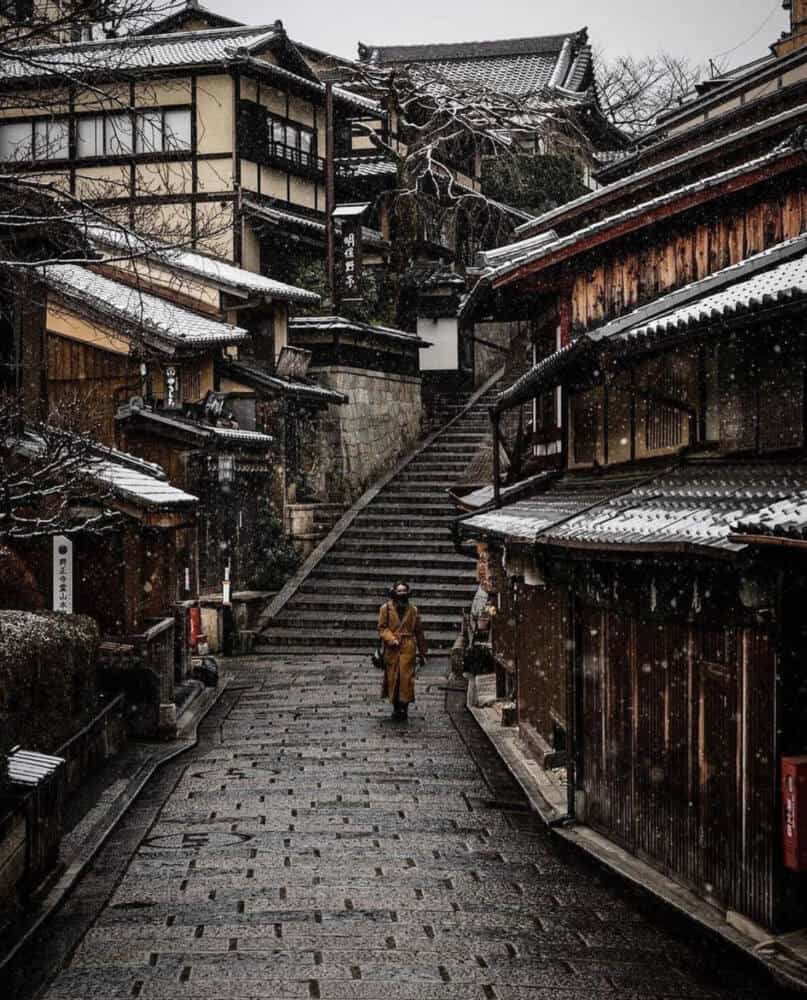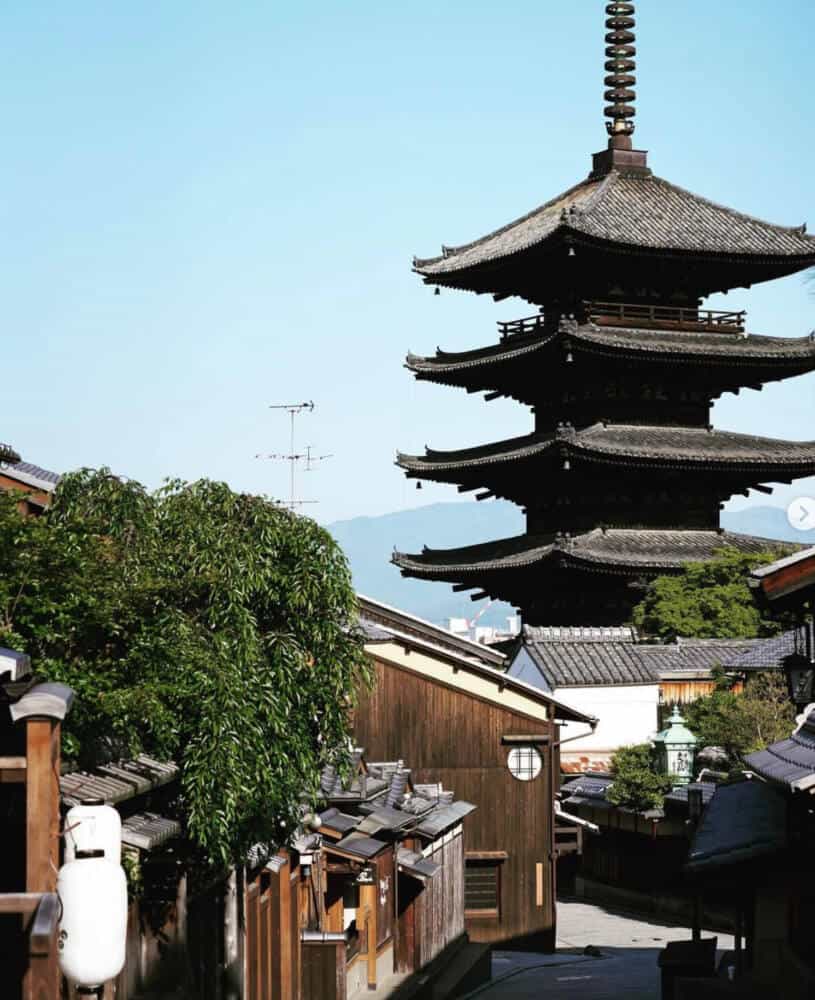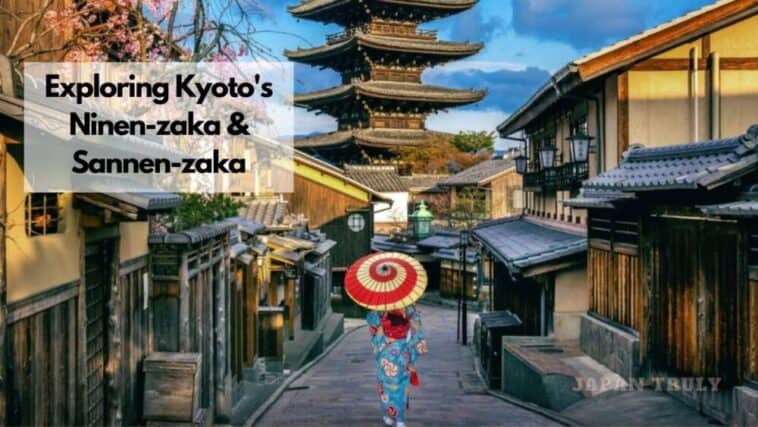Here’s a guide on Kyoto’s Ninen-zaka & Sannen-zaka. Check it out!
Kyoto, a city steeped in history and tradition, boasts enchanting streets that transport visitors back in time. Ninen-zaka and Sannen-zaka, nestled in the heart of the Higashiyama district, stand as living testaments to Japan’s rich cultural heritage.
The cobblestone paths and traditional architecture create an immersive experience that captivates all who wander through.
This guide invites you to discover the charm of Ninen-zaka and Sannen-zaka, offering insights into their historical significance, unique atmosphere, and the delightful exploration that awaits.
Page Contents
Exploring Ninen-zaka & Sannen-zaka: Kyoto’s Oldest Most Beautiful Streets
Exploring Ninen-zaka

Ninen-zaka, also known as Sannenzaka, is a historic street located in the Higashiyama district of Kyoto, Japan.

The name “Ninen-zaka” translates to “Two-Year Slope,” a reference to the legend that couples who walk its cobblestone path together may face challenges in the following two years, adding a touch of romantic intrigue to the atmosphere.
Starting Point and Strolling Upwards:
Embark on your journey at the base of Ninen-zaka, where the narrow street gently ascends, leading you through a time-honored journey.
The quaint charm of the surroundings immediately envelops you as you take your first steps on the well-preserved cobblestone path. Walking uphill, you’ll notice the transition from the bustling cityscape to a more serene, historical atmosphere.
Traditional Architecture, Shops, and Cafes:
The defining feature of Ninen-zaka is its preservation of traditional machiya houses, characterized by their wooden lattice windows, clay-tiled roofs, and elegant architectural details.
These structures, dating back to the Edo period, create a picturesque scene that transports visitors to a bygone era. .
As you stroll, take the time to appreciate the intricate designs and craftsmanship of these historical buildings.
Must-See Shops and Hidden Gems:
While every corner of Ninen-zaka has its own unique charm, there are specific shops that stand out as must-visit destinations.
Look out for stores specializing in handmade ceramics, traditional Japanese sweets, and local crafts. These establishments often showcase the craftsmanship and artistic traditions that define Kyoto.
As you meander through the narrow alleyways, keep an eye out for hidden gems such as small gardens, teahouses, or traditional Japanese inns (ryokan).
These tucked-away spaces offer a respite from the bustling street and provide an opportunity to immerse yourself in the tranquility of Kyoto’s historical ambiance.
The “2-Year Curse” Legend:
According to local superstition, couples who visit Ninen-zaka together may encounter challenges in the two years following their visit.
While the legend is more of a playful tale than a serious belief, it adds a layer of romance and whimsy to the experience, making Ninen-zaka a popular destination for couples and those seeking a touch of mystique.
In summary, exploring Ninen-zaka is like stepping into a living museum of Kyoto’s past. The traditional architecture, charming shops, and the legend that weaves through its cobblestone streets make it a must-visit destination for anyone seeking an authentic glimpse into Japan’s rich cultural heritage.
Take your time to savor the atmosphere, appreciate the craftsmanship, and uncover the hidden treasures that make Ninen-zaka a captivating journey through time.
Ascending to Sannen-zaka
As you ascend from Ninen-zaka to Sannen-zaka, the transition between these two historic streets unfolds seamlessly, offering a slightly different character and atmosphere.
The journey becomes a delightful exploration of Kyoto’s Higashiyama district, rich in cultural heritage and scenic beauty.
Transition and Incline:
The transition from Ninen-zaka to Sannen-zaka is marked by a gradual shift in the incline of the cobblestone path.
While Ninen-zaka gently ascends, Sannen-zaka presents a slightly steeper incline, adding a sense of anticipation as you climb higher. The change in elevation contributes to the distinct charm of Sannen-zaka and offers a different perspective of the surrounding landscape.
Character of Sannen-zaka:
Sannen-zaka retains the historical charm of Ninen-zaka but with a quieter and more secluded atmosphere.
The narrow lanes are flanked by well-preserved machiya houses, creating a sense of intimacy as you explore this traditional neighborhood. The architecture maintains the elegance and authenticity that define Kyoto, providing visitors with a glimpse into the city’s storied past.
- Related: Things To Do In Takayama
Kiyomizu Sannenzaka Museum:
Along Sannen-zaka, you may encounter the Kiyomizu Sannenzaka Museum, a cultural institution that offers insight into the history and arts of the Higashiyama district.

The museum provides a deeper understanding of the cultural significance of the area, showcasing artifacts, traditional crafts, and exhibitions that highlight Kyoto’s rich heritage.
Consider exploring the museum to enhance your appreciation of the district’s history.
Views of Yasaka Pagoda:
One of the highlights of ascending Sannen-zaka is the stunning view of the Yasaka Pagoda.
Positioned strategically on the hillside, the pagoda becomes a focal point, creating a picturesque backdrop against the traditional architecture of the street.
The views from Sannen-zaka provide a unique perspective of Kyoto, with the Yasaka Pagoda standing tall amidst the historic surroundings.
In summary, ascending to Sannen-zaka offers a journey of both physical and visual exploration.
The steeper incline, coupled with the unique character of Sannen-zaka, adds another layer to your Kyoto experience.
Whether you are drawn to the cultural insights of the Kiyomizu Sannenzaka Museum or captivated by the panoramic views of the Yasaka Pagoda, the ascent to Sannen-zaka promises to be a memorable and enriching part of your exploration of Kyoto’s historic streets.
Best Time to Visit Ninen-zaka & Sannen-zaka
To make the most of your exploration of Ninen-zaka and Sannen-zaka, consider the best time to visit, taking into account crowd levels, seasonal variations, and any special events.
Early mornings or late afternoons on weekdays are generally quieter, offering a more intimate experience.
The spring cherry blossom season and the fall foliage period are particularly popular but attract larger crowds, so plan accordingly if you want to witness these natural spectacles.
How to Get to Ninen-zaka & Sannen-zaka:
Ninen-zaka and Sannen-zaka are conveniently located in the Higashiyama district, making them accessible by various means of transportation.
If arriving from Kyoto Station, take a bus to the Higashiyama district or use the efficient Kyoto City Subway to reach the nearby Higashiyama Station. From there, the streets are within walking distance.
Alternatively, consider taking a taxi or using Kyoto’s bicycle rental services for a more leisurely approach.
Beyond the Streets of Ninen-zaka & Sannen-zaka
Extend your journey beyond the charming streets and explore nearby attractions such as the iconic Kiyomizu-dera Temple. Immerse yourself in the spirituality of the temple grounds and appreciate the stunning views it offers.
Venture into other corners of the Higashiyama district, discovering hidden temples, quaint alleys, and traditional shops that add layers to your Kyoto experience.
Conclusion
In the heart of Kyoto, Ninen-zaka and Sannen-zaka unfold like pages from a historical narrative, inviting visitors to step into a world where tradition and modernity coalesce. The enchanting streets, rich in culture and beauty, promise an unforgettable experience.
As you conclude your exploration, let the magic of Ninen-zaka and Sannen-zaka linger, inspiring a deep appreciation for Kyoto’s timeless allure. Embrace the journey, and let wanderlust guide your next adventure in this captivating city.
My writing focuses on the various aspects of Japanese lifestyle, from traditional tea ceremonies and flower arrangement to modern fashion trends and pop culture. Through my articles, I aim to share my passion for Japan and provide readers with a glimpse into the rich and diverse world of Japanese culture.
I believe that the key to understanding Japanese lifestyle is to appreciate the balance between tradition and innovation. While Japan has a rich cultural heritage that dates back centuries, it is also a country that is constantly evolving and embracing new ideas and technologies.
Whether you’re interested in learning about the latest fashion trends in Tokyo, or want to explore the ancient art of calligraphy, my writing will take you on a journey through the many facets of Japanese lifestyle. So join me as we explore the beauty and complexity of this fascinating culture together!





